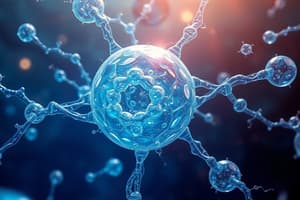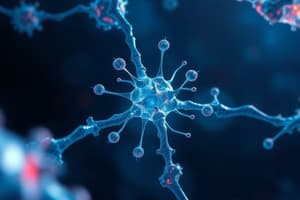Podcast
Questions and Answers
Which of the following are classified as macromolecules of life?
Which of the following are classified as macromolecules of life?
- Amino acids and glucose
- Water and salts
- Proteins and nucleic acids (correct)
- Vitamins and minerals
What is the fundamental unit of life?
What is the fundamental unit of life?
- Organism
- Atom
- Molecule
- Cell (correct)
Which of the following represents prokaryotic cells?
Which of the following represents prokaryotic cells?
- E.coli and Anemones
- E.coli and Phospholipids
- Yeast and Drosophila
- E.coli and Yeast (correct)
Which model organism is commonly used in molecular biology studies?
Which model organism is commonly used in molecular biology studies?
Which of the following is NOT a macromolecule of life?
Which of the following is NOT a macromolecule of life?
What is the primary function of lysosomes?
What is the primary function of lysosomes?
Under which conditions do lysosomal enzymes function optimally?
Under which conditions do lysosomal enzymes function optimally?
Where are the enzymes and membranes of lysosomes synthesized?
Where are the enzymes and membranes of lysosomes synthesized?
How do lysosomes obtain the materials they need to degrade?
How do lysosomes obtain the materials they need to degrade?
What is a key role of mitochondria in cellular processes?
What is a key role of mitochondria in cellular processes?
What does a phylogenetic tree depict?
What does a phylogenetic tree depict?
What fundamental features are shared among all cells?
What fundamental features are shared among all cells?
Which of the following is NOT one of the macro-molecules of life?
Which of the following is NOT one of the macro-molecules of life?
What role do model organisms play in studying molecular biology?
What role do model organisms play in studying molecular biology?
Which molecule is considered part of the 'molecules of life'?
Which molecule is considered part of the 'molecules of life'?
All living organisms descended from what type of cell?
All living organisms descended from what type of cell?
Which option correctly states a characteristic of cells based on their common evolutionary origin?
Which option correctly states a characteristic of cells based on their common evolutionary origin?
Which type of organisms are typically referred to as model organisms?
Which type of organisms are typically referred to as model organisms?
What is a common feature of both Bacteria and Archaea?
What is a common feature of both Bacteria and Archaea?
Which of the following distinguishes Archaea from Bacteria?
Which of the following distinguishes Archaea from Bacteria?
In which type of environment do Archaea typically thrive?
In which type of environment do Archaea typically thrive?
What is NOT a characteristic of prokaryotic cells?
What is NOT a characteristic of prokaryotic cells?
What statement about the genetic material in prokaryotes is correct?
What statement about the genetic material in prokaryotes is correct?
How do the cellular processes in prokaryotes compare to those in eukaryotes?
How do the cellular processes in prokaryotes compare to those in eukaryotes?
What is the primary structure that forms the cell membrane in all cells?
What is the primary structure that forms the cell membrane in all cells?
Which of the following is NOT a role of proteins in cells?
Which of the following is NOT a role of proteins in cells?
What is the significance of using bacteria as model organisms in molecular biology?
What is the significance of using bacteria as model organisms in molecular biology?
What is a key difference in the transcription and translation machinery of Archaea compared to Bacteria?
What is a key difference in the transcription and translation machinery of Archaea compared to Bacteria?
What defines eukaryotic cells?
What defines eukaryotic cells?
What is the role of nuclear pores?
What is the role of nuclear pores?
Which structure is responsible for lipid biosynthesis?
Which structure is responsible for lipid biosynthesis?
What composes chromatin in eukaryotic cells?
What composes chromatin in eukaryotic cells?
What distinguishes rough ER from smooth ER?
What distinguishes rough ER from smooth ER?
What is the primary function of the Golgi apparatus?
What is the primary function of the Golgi apparatus?
Which cytoplasmic component excludes the nucleus?
Which cytoplasmic component excludes the nucleus?
What is NOT a characteristic of ribosomes?
What is NOT a characteristic of ribosomes?
What are the two components of the nuclear envelope?
What are the two components of the nuclear envelope?
What does the endoplasmic reticulum produce?
What does the endoplasmic reticulum produce?
What are the membrane-enclosed sacs of the Golgi apparatus called?
What are the membrane-enclosed sacs of the Golgi apparatus called?
Which of the following is true about eukaryotic cell compartments?
Which of the following is true about eukaryotic cell compartments?
Which structure transports materials into and out of the nucleus?
Which structure transports materials into and out of the nucleus?
What term describes the fluid portion of the cytoplasm after removing organelles?
What term describes the fluid portion of the cytoplasm after removing organelles?
Flashcards are hidden until you start studying
Study Notes
Molecules of Life
- The molecules of life are proteins, nucleic acids, phospholipids, and saccharides (sugars).
- Proteins are chains of amino acids and are responsible for many functions in the cell.
- Nucleic acids carry genetic information, they are made of nucleotides.
- Phospholipids are amphipathic – both hydrophobic and hydrophilic – and form lipid bilayers, which make up cell membranes.
Cellular Life
- Cells are the fundamental units of life.
- There are two main types of cells: prokaryotic and eukaryotic cells.
- Prokaryotic cells are simpler and do not contain a nucleus or other membrane-bound organelles.
- Eukaryotic cells are more complex and have a nucleus and various membrane-bound organelles.
- The nucleus contains the cell's genetic material, DNA.
- The DNA in eukaryotic cells is organized into linear pieces called chromosomes.
- The nuclear envelope surrounds the nucleus and has pores that allow the exchange of molecules between the nucleus and the cytoplasm.
- The endoplasmic reticulum (ER) is a network of membrane-enclosed sacs called cisternae.
- The ER is involved in lipid biosynthesis and protein synthesis, and produces vesicles for transport.
- Ribosomes are large molecular complexes that translate mRNA into proteins. They are found both bound to the ER and free in the cytosol.
- The Golgi apparatus receives transport vesicles from the ER, modifies proteins and lipids, and sorts them into vesicles that are released to other parts of the cell.
- Lysosomes are digestive organelles that contain enzymes that degrade macromolecules.
- Mitochondria are responsible for generating energy from nutrient molecules in the form of ATP.
Prokaryotic Cells
- Prokaryotic cells do not have a nucleus or other membrane-bound organelles.
- Their genetic material is mainly a circular DNA molecule located in the nucleoid.
- They also have small circular DNA molecules called plasmids.
- Prokaryotes have a cell wall made of proteins and sugars.
- Prokaryotes, specifically bacteria, are often used as model organisms in molecular biology.
Model Organisms
- Model organisms are simple organisms used to study complex biological processes.
- Scientists use model organisms because they are easier to manipulate, grow and study than more complex organisms.
- Examples of model organisms include: E. coli (bacteria), yeast, C. elegans (roundworm), Arabidopsis thaliana (plant), Drosophila (fly), zebrafish, and mouse.
Evolutionary Relationships
- All living organisms have a common ancestral cell.
- Phylogenetic trees depict evolutionary relationships between different organisms.
- Many fundamental features of cells are shared due to their common evolutionary origin.
- The study of simple model organisms can be used to learn about molecular biology in more complex organisms.
Studying That Suits You
Use AI to generate personalized quizzes and flashcards to suit your learning preferences.




